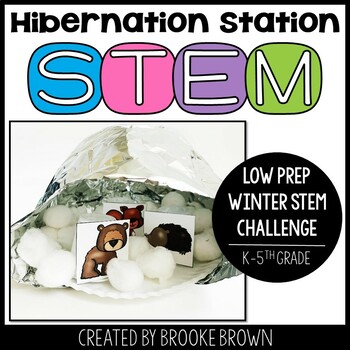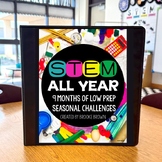Hibernation Station STEM Challenge (Winter STEM Activity) - Animals in Winter
- PDF
What educators are saying
Also included in
- ***SAVE BIG WHEN YOU PURCHASE THIS DISCOUNTED ALL YEAR BUNDLE!***This best-selling bundle contains 9 months of engaging STEM & STEAM Activities for your little engineers, with 3 STEM Challenges and 1 Bonus Brainbuilder per month for a total of 36 NGSS Aligned STEM Activities!*INCLUDES BACK TO SCPrice $59.99Original Price $111.00Save $51.01
- This winter themed STEM/STEAM package is perfect to engage your elementary engineers in January! Three STEM challenges and one Bonus Brainbuilder are provided and can be completed as stations or in isolation.Includes the following LOW PREP WINTER STEM ACTIVITIES:Sledding RampHibernation StationSnowbPrice $8.00Original Price $12.00Save $4.00
Description
***SAVE BIG WITH THE WINTER STEM BUNDLE!***
This low prep, winter themed STEM/STEAM activity is perfect to engage your elementary engineers in January!
Includes the following components for HIBERNATION STATION ACTIVITY:
- Detailed Lesson Plan with Standards, Supply Checklist, and Suggested Read Alouds
- Digital Google Slides Notebook for Paperless Recording and Interactive Displays
- Key Visual Vocabulary Chart
- Photo of Possible Product
- Digital Anchor Chart
- Student Instructions
- QR Code Research Videos and Website
- Differentiated Student Recording Sheets (K-1st and 2nd-5th)
- Reflection Discussion Chart
- Grading Rubric
- Supply Request Letter for Parents
INTERESTED IN STEM FOR THE ENTIRE YEAR?!! Click Below!
⇒Feedback and Followers
Click the Green ★ to follow my store and get notifications of new product launches and freebies! Did you know that you can receive credit toward future TpT purchases by reviewing this product? If you enjoy this product, please leave a review at the product page or through "My Purchases" under "My Account" at TpT. Ratings make the TpT world go round! :-)
⇒I'd LOVE to connect with you!
⇒Terms of Use
©Brooke Brown, LLC at Teach Outside the Box
By purchasing and/or downloading this electronic file, you agree to the terms of use as stated below. For personal use/single classroom use only. No part of this document may be distributed, posted on the internet, copied, sold, or edited without direct permission from the author. Violations are subject to the penalties of the Digital Millennium Act. To purchase additional sharing licenses, please visit my store. All contents of this document are under copyright protection including all text, graphics, contents, and fonts. All graphics and fonts are also protected by copyright from their original author/artist.
Thank you so much for visiting my store!







